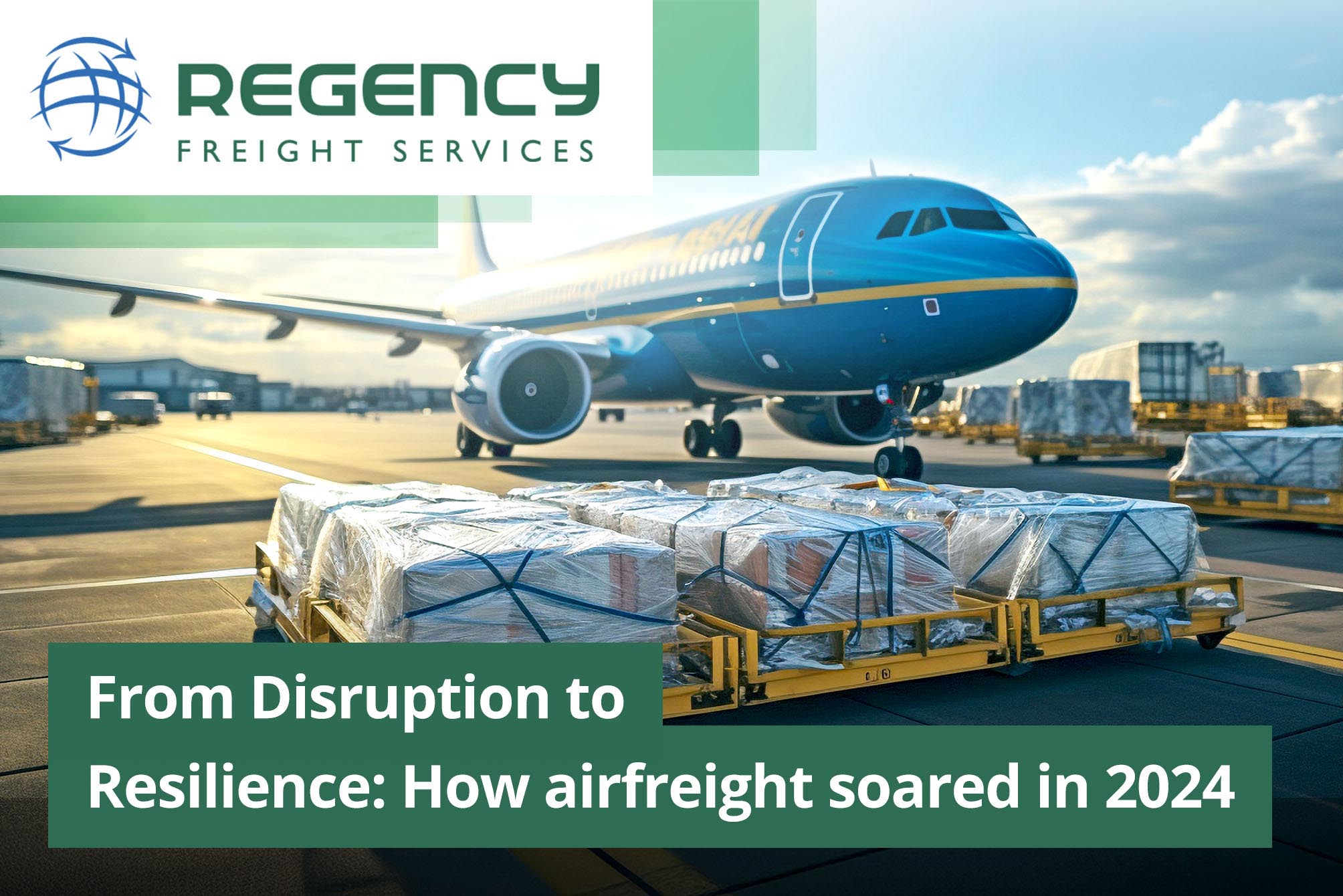From Disruption to Resilience: How airfreight soared in 202415 January 2025
2024 was a year of strategic adjustments and investments with an eye toward the future. The lingering effects of the pandemic, including persistent supply chain disruptions and labour shortages, weighed heavily on operations. Geopolitical tensions and inflationary pressures further complicated the global trade landscape, testing the industry’s resilience. Despite facing global uncertainties, the industry has shown the ability to adapt and thrive through changing market dynamics. The industry managed immediate challenges, like meeting e-commerce demands and navigating disruptions, while setting the stage for long-term growth through sustainability and market expansion, proving its resilience and adaptability in the face of an evolving landscape. “2024 was a year of recalibration for airfreight, balancing capacity growth, sustainability ambitions, and evolving market demands,” Frederic Brun, Head of Commercial Cargo and Logistics at Liege Airport, outlined. “The trend this year has been strong from the start of the year, driven by a strong economic outlook and higher consumer spending. The first half of the year was also the first time in 4 years that the overall market anticipated the Fed rate cuts, which finally occurred on 18th September,” Michael Teoh, Head of Strategy at CargoTech, explained. “The ongoing surge in e-commerce, fuelled by shifting consumer behaviours, continued to drive demand,” Brandon Fried, Executive Director of the Airforwarders Association, continued. “At the same time, the industry’s commitment to sustainability and adoption of advanced technologies—such as artificial intelligence and automation—helped. “The air cargo industry as a whole did not expect strong growth, but nevertheless proved once again how quickly and flexibly it can react to the market,” Michael Zach, Senior Vice President Ground Handling & Cargo Operations at Vienna Airport, concurred. The ability to remain agile and customer-centric, supported by strong and strategic partnerships, has been a key factor in the industry’s success. “This flexibility has enabled us to quickly adapt to market changes and deliver tailored solutions, while strengthening our collaborations to create long-term value,” M. Yassine Berrada, Vice President of Cargo at Royal Air Maroc, explained. New opportunities For example, Vietnam is showing a continuous increase as various multinational companies relocate their production plants from China to Vietnam. “Emerging markets are offering considerable opportunities for businesses to expand. Countries such as Turkey, Romania, Poland and Hungary hold exceptional growth potential for UK-based firms, thanks to increasing access to high-speed internet services, more mobile commerce, and rising numbers of consumers with spending power,” Duncan Heron, VP, DHL Express UK, added. “In response to growing market opportunities, particularly in Africa, Royal Air Maroc Cargo strategically reviewed its network, focusing on connecting major trade hubs to our African network , thereby facilitating smoother and faster trade flows,” Berrada stated. Geopolitical conflicts in Eastern Europe and the Middle East significantly disrupted traditional supply chains. This led to an increased reliance on alternative routes and cargo charters, as companies sought to navigate the instability and ensure the continuity of their operations. “A notable shift in trade flows also emerged, with the diversification of manufacturing bases to countries like India and Vietnam. This reshaped airfreight corridors, reducing the industry’s reliance on traditional China routes and promoting a more balanced distribution of cargo traffic,” Colin Charnock, CEO of Trans Global Projects, highlighted. “We experienced a mixed performance in 2024. There was a good recovery in perishable exports from East Africa to the Middle East and Europe; however, capacity limitations have resulted in higher yields for Flowers in Europe,” Sanjeev Gadhia, CEO of Astral Aviation, outlined. Capacity concerns As demand surged, carriers faced difficulties meeting the growing volume of shipments, leading to bottlenecks. Labour disruptions, including strikes and shortages at key airports such as Heathrow and Frankfurt, caused delays and capacity shortages at critical junctures. Maritime shipping disruptions, including weather-related bottlenecks, pushed businesses toward airfreight as a reliable alternative. “These disruptions underscored the importance of labour stability and effective workforce management in maintaining the smooth operation of air cargo networks,” Charnock highlighted “The ongoing U.S.-China trade tensions and evolving global trade patterns further disrupted supply chains, pushing businesses to depend more heavily on airfreight for its speed and reliability, De Bruijn added. “This capacity crunch, compounded by geopolitical instability and labour disruptions at key transportation hubs, underscored the fragile balance in global logistics,” Brandon Fried, Executive Director of the Airforwarders Association, expressed. “While market dynamics remained positive overall, there were notable imbalances between regions. Asia stood out with exceptional growth, particularly in e-commerce volumes, which saw a significant surge globally,” Adrien Thominet, Executive Chairman of ECS Group, expressed. e-commerce The quarter ending September 2024 recorded the second-highest quarterly cargo-tonne kilometers, a figure surpassed only during the pandemic in 2021. This growth was largely driven by booming e-commerce demand in the U.S. and Europe, coupled with continued disruptions in maritime shipping. Currently accounting for approximately 20 percent of global airfreight volume, the global e-commerce market is expected to grow at a compound annual growth rate (CAGR) of 7 percent per annum until 2030. With consumers expecting faster and more reliable delivery options, this has sustained a high demand for airfreight capacity, especially for time-sensitive goods, with consumer spending at a high even as inflation persisted. While stabilising in volume, the surge in e-commerce traffic strained capacity for general cargo, particularly out of Asia. The growing demand for fast, reliable deliveries often stretched resources that were traditionally set aside for other types of shipments. New entrants such as Temu, Shein and TikTok have changed the landscape on delivery expectations. Gone are the days when consumers placed an order for a product and waited for it to be delivered to the store. Nowadays, they want instant gratification. “This demand led to tight capacity and fluctuating rates, especially noticeable in routes between Asia and North America,” Kirsten De Bruijn, Executive Vice President of WestJet Cargo, said. “While e-commerce has been around, the wider acceptance on the convenience of buying any range of goods online is pushing the boundaries. If a wide range of goods is available online, it trickles down to the supply chain and how goods are packed and delivered across the world,” Teoh stated. e-commerce cargo is not affected by seasons and has a constant demand throughout the year, which is a factor that reduces market uncertainty for cargo airlines and forwarders. “The traditional pattern of air cargo demand, which is low in spring and summer and high in fall and winter, is disappearing due to the activation of e-commerce cargo, which maintains a steady volume throughout the year,” Hoon lim, Deputy Director at Incheon International Airport Corporation, said “Capacity has been heavily utilised and shifted to Asia by some airlines during winter schedules, which left forwarders with limited options. Asia-Europe capacity grew by 10 percent from summer due to the fast-growing demand, creating further imbalances between trade lanes. This prompted logistics providers to rethink their operational strategies, balance carrier partnerships and find new ways to optimise load management,” Chris Bode, Vice President ofGlobal Air Freight for Rhenus Air and Ocean, said. “The e-commerce sector turned out to be the engine of development. We have seen an increase in demand from many of our customers, whose ULD requirements were flexibly adapted over the course of the year in order to take advantage of the market opportunities arising,” Dr Jan-Wilhelm Breithaupt, CEO Jettainer, explained. “Advanced technology, including demand forecasting and digital freight platforms, has helped to streamline operations and improve efficiency, while mitigating geopolitical tensions and fluctuating fuel prices,” Duncan Heron, VP, DHL Express UK, continued. Traffic levels return The industry saw unprecedented demand, with global cargo tonne-kilometres (CTK) growing consistently. By June, there was a 14.1 percent year-on-year increase, and this momentum continued throughout the year. Available cargo tonne-kilometres (ACTK) also grew, with an 8.8 percent increase compared to June 2023. “Record-high capacity, supported by a recovery in passenger belly-hold capacity and dedicated freighters, placed downward pressure on rates. However, yields remained 46 percent above 2019 levels, reflecting demand for specialized shipments,” Frederic Brun, Head of Commercial Cargo and Logistics at Liege Airport, outlined. “At Heathrow, we experienced strong cargo growth in the 11 months to end-November, with tonnage 11 percent up on the same period in 2023,” James Golding, Head of Cargo at Heathrow Airport, concurred. “This is a result of strong build back in belly hold cargo capacity, particularly to key export origins such as China, and strong demand from regions where ocean freight has been disrupted such as the Middle East.” An interesting trend that emerged was the steady growth in passenger traffic, ranging from high single-digit to double-digit growth, which brought more belly cargo capacity to the market. According to IATA’s Air Passenger Market Analysis, international passenger traffic in Asia increased significantly by 17.5 percent year-on-year (YoY) in October 2024, following a similar trend in previous months this year. “This additional space allowed airlines and logistics providers to introduce new routes and transshipment options, opening up previously underserved regions and creating opportunities to tap into emerging markets,” Bode highlighted. “This was especially beneficial for regions like Southeast Asia that had limited air freight connections, giving companies a chance to expand their reach and diversify their market presence. However, freighter deliveries have been quite slow this year, leaving overall capacity growth still lagging behind demand, despite the decent growth in belly capacity.” Sustainable focus Sustainability became a central focus in 2024. The industry’s gradual shift toward Sustainable Aviation Fuel (SAF) gained traction, with many companies making serious commitments and planning future investments in lower emissionsoperations. “Frist mandates for SAF usage will be implemented by the European Commission from January 2025. 2024 served as a crucial year of preparation, with businesses signaling a long-term commitment to environmental responsibility and cleaner operations,” Bode said. “Several industry players actively invested in usage of sustainable aviation fuels and more efficient aircraft, aiming to reduce carbon emissions and align with global emission targets,” Radhesh Menon, Vice President of Product Management and Strategy, Cargo and Logistics, at IBS Software, added. With commitments to net-zero emissions by 2050, industry efforts included sustainable aviation fuels and electrification, but challenges in scaling green solutions persisted “Substantial investments in eco-friendly initiatives such as Sustainable Aviation Fuel (SAF) and innovative emissions reduction technologies have marked a shift toward greener logistics practices, aligning with the global push for sustainability,” Thominet laid out. Investments in sustainability have been a cornerstone of many strategies. “This year, we finalised complete study to implement in the beginning of 2025 an important renewable energy project. These initiatives are part of our broader commitment to reducing our environmental footprint and supporting global sustainability goals. We also signed this year the Buckingham Palace Declaration for wild life trade protection and are ATAT IWT members,” Berrada laid out as an example of industry efforts. Digital developments 2024 was also a year of digital transformation for the industry, with companies embracing data-driven tools and platforms to enhance efficiency and transparency. “This trend not only optimised operations but also reinforced trust and collaboration within the supply chain,” Thominet declared. “These tools have revolutionised how we manage bookings and optimise revenue, offering our customers real-time booking capabilities and streamlined operations,” Berrada added. For example, between 60 and 70 percent of global cargo is estimated to be un-or-under-insured. This year saw that tide begin to turn. “New digital tools enable real-time risk assessment and tailored coverage for air shipments with minimal manual intervention, reflecting broader trends towards greater efficiency and precision. These embedded, data-driven innovations will make international shipping faster, more cost-effective, and reliable,” Eyal Goldberg, CEO of Breeze, continued. The industry also saw a renewed focus on supply chain digitalisation, exemplified by the adoption of IATA’s One Record initiative. “Many iCargo customers explored this initiative in greater depth, with several engaging in proof-of-concept projects alongside their partners. Some even began preparations to productionize One Record, highlighting the initiative’s strong potential for transforming cargo operations,” Menon said. “On the compliance front, regulatory bodies in the U.S. and Europe made significant moves to improve the quality of data, particularly for e-commerce shipments. These efforts reflect the growing importance of enhanced transparency and accountability in global trade. “With solid growth, advancements in technology, strengthened compliance, and a strong commitment to sustainability, the sector seems well-positioned to take on 2025!” |
|
   |
